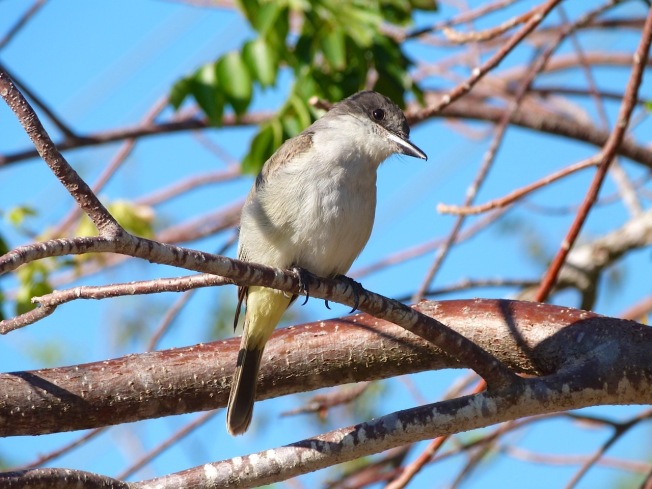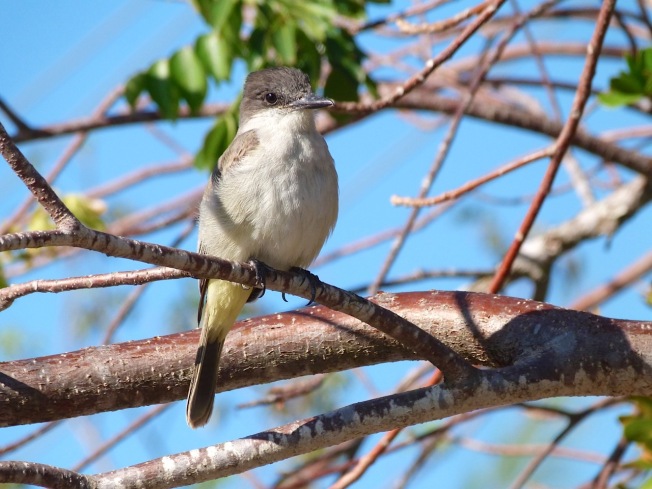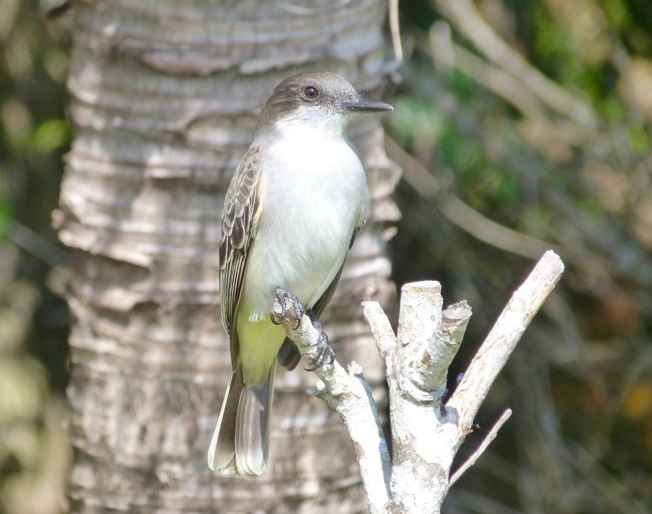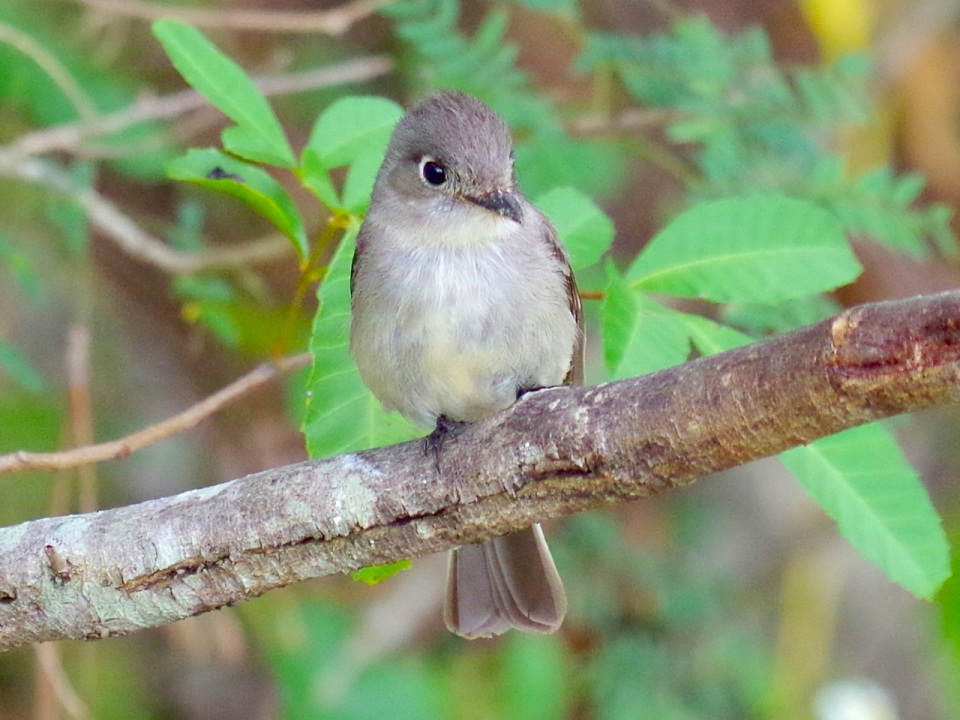
Loggerhead Kingbird with bee. Note dark head, yellowish underside
‘TYRANTS OF ABACO’: FLYCATCHER ID (1)
LOGGERHEAD vs GRAY KINGBIRD

Gray Kingbird: note dark eye ‘mask’, lighter head, mainly white underside & notched tail
Abaco has 275 (or so) recorded bird species. Omitting the transients, vagrants and (frankly) oddities – hello, feral peafowl of Casuarina – and concentrating on the residents and the summer / winter migrants brings the checklist down considerably. Maybe to around 200. But there is still an awful lot of scope for species confusion. This is frequently found with the warblers (37 species, mostly yellow), shorebirds and (my particular blind spot) gulls & terns with all their gender, age, season and breeding plumage variations. There is one common confusion that surrounds just 4 birds. I’ve decided to tackle the issue because these are the birds I am most frequently asked by people to identify. They send me their photos or a link, or post them on my FB page, and I am always delighted to help. Except… I get confused myself sometimes. So now I plan to demystify the Tyrant Flycatchers (Tyrannidae) of Abaco once and for all. Or for the time being, anyway.
ABACO’S TYRANT FLYCATCHER SPECIES

There are 14 tyrant species recorded for Abaco, as listed in the checklist clip above taken from “THE BIRDS OF ABACO” (a FORK-TAILED FLYCATCHER was seen recently for the first time on Abaco, and will in due course be added to the checklist). You’ll be relieved to learn that we can at once dispense of 10 of the above for present purposes. In practical terms – i.e. everyday life – the only flycatchers you need to be concerned with are the 4 underlined in red above: Cuban Pewee, Gray Kingbird, La Sagra’s Flycatcher and Loggerhead Kingbird. The underlined codes provide useful information for each bird .
- PR 3 of the 4 are permanent residents – not the gray kingbird, which is SR a summer resident
- B these 4 are the only flycatchers that breed on Abaco
- 1 all 4 are widespread, commonly and easily found. All other candidates are unusual to very rare

Which is this?
LOGGERHEAD Tyrannus caudifasciatus vs GRAY Tyrannus dominicensis
DIFFERENCES and SIMILARITIES
TOP TIP ANY KINGBIRD SEEN IN WINTER WILL BE A LOGGERHEAD
- A kingbird seen between (say) October and March is a Loggerhead. Grays are strictly summer visitors
- Both are medium size birds and roughly the same size as adults (around 23 cms)
- Loggerheads have dark brownish heads (some say black), grays have lighter, slate-coloured heads
- Loggerheads have a ‘squared’ tip to the tail; grays have a notched tip
- Loggerheads may have a whitish fringe at the tip of the tail; grays not so
- Loggerheads have yellowish tinges to their white undersides & forewings; grays less so or not at all
- Grays have a dark or black ‘mask’ through the eyes, often clear but not always easy to see
- Loggerheads allegedly have inconspicuous orange head crests; grays are red. I’ve never seen either!
- [*RH opinion alert*] Grays have larger, heavier beaks than loggerheads
- Grays are territorially aggressive; when they turn up, the loggerheads tend to retreat to the forest
Here is how David Sibley shows the differences


Illustrations: David Allen Sibley
Gray or Loggerhead? Note the light head, discernible mask & notched tail
Loggerhead or Gray? Note the darker head and no mask
GRAY KINGBIRDS: masked & notch-tailed


CLASSIC LOGGERHEAD: squarer tail, yellowish underside, dark head, hint of a crest
COMMON TO ALL FLYCATCHERS An Insect ‘Hook’ at the tip of this Loggerhead’s ‘top’ bill
MEMORABLE FACT TO DEPLOY IN CONVERSATION
The collective names for a group of kingbirds are: a Court, a Coronation, or a Tyranny
I hope this helps with ID, but it’s fair to say that even the birds shown here don’t conform strictly to the rules. A couple of gray kingbirds have distinctly yellowish undersides. And the real problem is this: you see a medium-size bird. It is hawking for insects. It is high summer. It’s a kingbird. It is 150 feet away, and against the sun. It’s just a darkish bird. You can’t see a notched tail or yellowish underside, still less a mask. But at least you can be confident that you can restrict the ID to just 2 birds… Just ask me which, and I’ll do my best…
NEXT UP LA SAGRA’S FLYCATCHER vs CUBAN PEWEE
Credits: Tom Reed (1), Tom Sheley (2, 4, 5), Gerlinde Taurer (3), Mrs RH (6, 7), Alex Hughes (8), Charles Sharp (9), Dick Daniels (10), Peter Mantle (11), RH (12); Illustrations David Sibley



















































You must be logged in to post a comment.